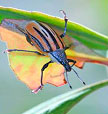Diaprepes Root Weevil Pest Profile


(Photos by: W. Briones, CDFA)
Description
Diaprepes root weevil (DRW) adults are medium sized weevils, 10 - 19 millimeters in length (3/8" - 3/4"), with numerous color forms ranging from gray to yellow to orange and black. Eggs are oval, whitish, and 1 mm in length. Full grown larvae are C-shaped and whitish, and can reach 25 millimeters (1") in length. Pupae are orange and are found inside pupal chambers beneath the ground.
Distribution
DRW occurs in the Bahamas, Bermuda, Cuba, Dominican Republic, Haiti, Jamaica, Puerto Rico, and the Lesser Antilles. This weevil was accidentally introduced into Florida in the 1960s where it has caused extensive damage. It is estimated that DRW causes about $70 million in damage annually in Florida. It has also recently become established in a small area in south Texas. In California it has become established in portions of Los Angeles, Orange and San Diego counties. If you see this pest in other regions of the State, please notify your county agricultural commissioner.
Life Cycle
This beetle typically has a one year life cycle, although considerable variation exists in developmental times. Most adults emerge in spring and early summer, but others may emerge throughout the year. An adult female weevil lays clusters of eggs on leaves that are folded and glued together. The eggs hatch in 7-10 days, and the newly emerged larvae drop to the soil. The larvae enter the soil and feed upon the roots of plants for several months. The larvae then pupate in the soil. Adults hatch from the pupae in about 2-4 weeks, but may remain in the pupal chamber for a month or more before emerging from the soil. Generation times vary between 5-18 months depending on environmental conditions. Adults typically live 4-5 months, and a female can lay around 5000 eggs in her lifetime. Natural dispersal of the DRW is slow because although the adults are capable of flight, they tend to stay on whatever host plant they first encounter and the dispersal rate of adults is estimated to be less than 300 meters (1000 feet).
Hosts & Economic Importance
This weevil will feed on about 270 different plants from 59 plant families including citrus, guava, sugarcane, vegetables, potatoes, strawberries, sweet potatoes, papaya, mahogany, and many ornamentals. This weevil damages both the leaves and the roots of plants. The adults damage leaves by chewing semi-circular areas out of the leaf margin. There may also be frass or weevil droppings near the areas that have been fed upon. The grub-like larva feeds upon the roots of a plant, eventually weakening or killing the plant. In addition, the root damage makes plants susceptible to root rot disease (Phytophthora spp.).
